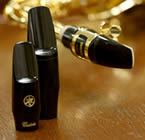How the Saxophone is Made
Mouthpiece materials
Top-of-the-line ebonite
There are two types of mouthpiece materials: ebonite for the top-of-the-line custom models, and phenol resin for all others. They appear to be the same, but their difference becomes apparent when played.
Ebonite is also used to make expensive fountain pen casings. It excels in durability and weather resistance. Sulfur is kneaded into natural rubber, which is then fired in an oven. It is an involved process that can take as long as 16 hours. For this reason, there are only 2 or 3 material makers left in the world who do this type of work. Even so, if you do not use the traditional materials, the sound of the instrument is affected, and thus Yamaha makes its own ebonite mouthpieces.

The ebonite mouthpiece is in front, the phenol resin mouthpiece is in back.
